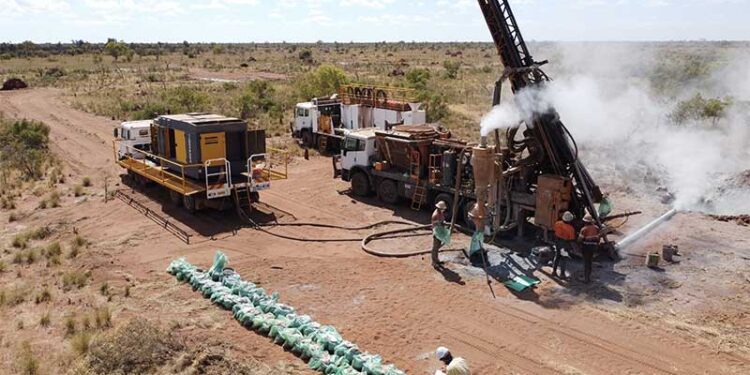RareX Limited (ASX: REE) has received further exceptional wide, high-grade results from diamond drilling targeting the primary zone at its 100%-owned Cummins Range Rare Earths Project in the Kimberley Region of Western Australia.
Managing Director, Jeremy Robinson, said the results – from holes CDX0002, CDX0003, CDX0004, CDX0005 and partial results for CDX0011 – have provided clear evidence of the significant potential of the primary zone to contain wide zones of high-grade mineralisation, reinforcing the opportunity to substantially increase the current Mineral Resource of 18.8Mt at 1.15% TREO + 0.14% Nb2O5 (Indicated Resource of 11.1Mt at 1.32% TREO + 0.17% Nb2O5; Inferred Resource of 7.7Mt at 0.88% TREO + 0.11% Nb2O5).
“These exceptional results are a game-changer for Cummins Range,” Mr Robinson said.
“The diamond drilling completed towards the end of the year has been geared towards unlocking the potential of the primary zone and showing that we have a potentially much larger and higher-grade project on our hands here. These results strongly vindicate that belief.
“Partial assays from CDX0011 have returned some of the highest grades ever recorded at Cummins Range, including a fantastically high-grade zone grading 10.6% TREO – rarely seen in deposits like this. Plus, we have a world-class 103 metre intercept in hole CDX0004, in an area where previous explorers believed the mineralization had been upgraded by weathering processes.
“Instead, we have a very large zone of primary mineralization, which is a very exciting development for the Project. “We are looking forward to receiving the balance of the assays and planning our next phase of exploration at this rapidly evolving and growing deposit.”
Assay results for 93m to 141.9m down-hole have been received for drill hole CDX0011, with the zone returning very high-grade results of 21.9m at 3.1% TREO with 0.6% NdPr and 0.2% Nb2O5, including 3m at 10.6% TREO with 1.8% NdPr.
Importantly, this fresh rock intersection is interpreted to be true width and has been drilled 35m down-dip of the previously announced drill intercept from hole CRX0063 (41m @ 2.4% TREO with 0.5% NdPr and 0.5% Nb2O.
Drill hole CDX0004 has assayed a whopping 102.97m at 1.6% TREO with 0.3% NdPr and 0.4% Nb2O5.
This hole was drilled into an area that was previously interpreted by previous explorers to be an area where rare earth minerals have been upgraded through weathering processes.
Instead, the hole has passed through a wide breccia zone which sits in the hanging wall position of the Main Fault. This breccia zone has consistent wide intervals of 1% to 2% TREO and strong niobium mineralization as shown in previously announced drill-holes that were also drilled into this zone – CDX0007 61.4m at 1% TREO with 0.2% NdPr and 0.3% Nb2O5 (75m to the west), and CRX0066 40m at 1.8% TREO with 0.4% NdPr and 0.3% Nb2O5 (36m to the north).
The rare earths and niobium grade appear to be increasing to the east with a higher grade zone of 46.97m at 2% TREO with 0.4% NdPr and 0.5% Nb2O5 in hole CDX0004.
The lower half of the breccia is more strongly mineralized, leading into the interpreted position of the Main Fault.
Niobium results immediately above the Main Fault are also very elevated with an exceptional intercept of 9m at 1% Nb2O5 and 2.3% TREO.
Holes CDX0002 (lost before drilling through the Main Fault target area) and CDX0005 have drilled through several newly discovered mineralised zones in the hanging wall and footwall position. These new zones vary in width and grade.
The most notable is a shallow intercept in hole CDX0002 – 11.3m at 2.4% TREO with 0.4% NdPr and 0.2% Nb2O5 including a very high-grade interval of 3.1m at 7% TREO with 1.8% NdPr.
Once all assays are received, these new zones will be mapped across the deposit. Hole CDX0003 produced high-grade results in the Main Fault position with 23.9m at 2.5% TREO with 0.5% NdPr and 0.3% Nb2O5, including 2.3m at 7.3% TREO with 1.7% NdPr and 0.6% Nb2O5.
This hole was drilled as an in-fill and metallurgical drill hole for the oxide portion of the resource. The high-grade mineralisation starts 20m below surface and is interpreted to be >80% true width. This hole, along with CDX0004, will be used for numerous metallurgical test work studies by local expertise in Western Australia.
Diamond core drilling has significantly advanced the geological understanding of the Cummins Range deposit and continues to deliver high grade rare earths and niobium mineralisation.
The drilling of multiple new zones in the hanging wall and footwall to depths beyond expectations is very exciting and shallow wide rare earths and niobium intercepts in the breccia zone is even better.
For further information please visit: https://www.rarex.com.au/












